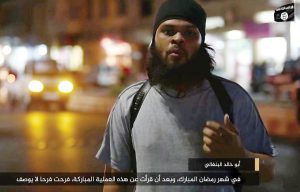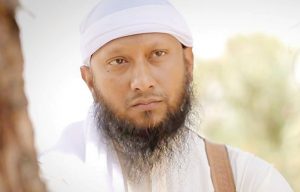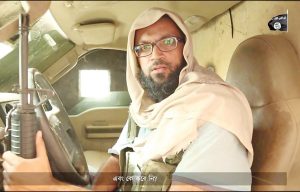There have been a number of reports of Bangladeshis, both locals and expatriates, joining the terrorist group Islamic State over a period of about three years. Some have travelled straight to Syria to join IS while others were radicalised abroad while studying or working and then moved to the Middle East. A significant number of IS members are also citizens of many different countries who are of Bangladeshi descent. Some of these people have also reportedly died in battles in Syria. So how many Bangladeshis or people of Bangladeshi descent are actually involved in the terrorist group? Law enforcement does not have an exact count, but senior police officials claim it cannot be more than 20 people. However, this correspondent’s investigation has found that at least 50 people have left the country to join IS, and at least the same number of foreigners of Bangladeshi origin can also be added to the list. Police counter-terrorism chief Monirul Islam said that his unit had about 20 names of people who had left the country for Syria.
 “We have information that most of them have been killed. We think that those who are still in Iraq or Syria will not be able to enter the country because their names are with the immigration police,” he said. “These people have been blacklisted. The immigration police are being very cautious about this. We are watching those who come from countries like Iraq or Syria very carefully.” The officer said it would be very difficult for IS terrorists to return to the country and therefore there was no reason to fear that they would come back, organise and perpetrate terrorist acts. “Only one man who went to Syria to fight and came back because of ideological differences was arrested immediately upon arrival. He is now in jail,” he added. Law enforcement sources said various agencies became aware by the end of 2014 that many young men were planning to travel to Syria to join IS. Some had already left. A group named ‘Ex-cadet Islamic Learning Forum’ played a major role in recruiting these young men. The head of this Facebook-based group was Sujit Debnath, who was then studying in Japan, and had converted to Islam and taken the name Saifullah Ozaki. With him were around 20-25 people including Aminul Islam Beg, Sakib Bin Kamal, Junnun Sikder, Nazibullah Ansari and Asadullah Galib from Bangladesh, ATM Tajuddin who lived in Australia. This entire group was actively recruiting people to go fight in Syria. On November 15, 2015, detective police in Dhaka arrested Kazi Saifuddin Yahya, a garments factory owner.
“We have information that most of them have been killed. We think that those who are still in Iraq or Syria will not be able to enter the country because their names are with the immigration police,” he said. “These people have been blacklisted. The immigration police are being very cautious about this. We are watching those who come from countries like Iraq or Syria very carefully.” The officer said it would be very difficult for IS terrorists to return to the country and therefore there was no reason to fear that they would come back, organise and perpetrate terrorist acts. “Only one man who went to Syria to fight and came back because of ideological differences was arrested immediately upon arrival. He is now in jail,” he added. Law enforcement sources said various agencies became aware by the end of 2014 that many young men were planning to travel to Syria to join IS. Some had already left. A group named ‘Ex-cadet Islamic Learning Forum’ played a major role in recruiting these young men. The head of this Facebook-based group was Sujit Debnath, who was then studying in Japan, and had converted to Islam and taken the name Saifullah Ozaki. With him were around 20-25 people including Aminul Islam Beg, Sakib Bin Kamal, Junnun Sikder, Nazibullah Ansari and Asadullah Galib from Bangladesh, ATM Tajuddin who lived in Australia. This entire group was actively recruiting people to go fight in Syria. On November 15, 2015, detective police in Dhaka arrested Kazi Saifuddin Yahya, a garments factory owner.
 According to his confessional statement in court, Yahya met Ozaki in mid-2013 at the Peace International School in Uttara where his son studied. Ozaki introduced him to a man named Muhib. Muhib later went to Japan in a scholarship. A student of Sylhet Cadet College, Muhib resigned while working as a para-commando member of the army. He disappeared while in Japan. Law enforcement believes Ozaki indoctrinated him and sent him to Syria. Police later learned that Peace School preached radical views and engaged the students in different activities of Peace TV, run by controversial India-based televangelist Zakir Naik. Its two branches and other affiliated schools were shut down in August 2016. According to Yahya’s statement, when Ozaki returned to Bangladesh in mid-2014, he introduced Yahya to another young man named Gazi Sohan. Sohan has been to Syria to fight for IS and returned. He is now in jail. Yahya also said that Nazibullah Ansari was radicalised by Ozaki and went to Syria with his help. Ozaki took Tk75,000 from Yahya saying he was buying food for Syrian refugees. He reportedly collected money from many Bangladeshis and sent many people to Syria to fight.
According to his confessional statement in court, Yahya met Ozaki in mid-2013 at the Peace International School in Uttara where his son studied. Ozaki introduced him to a man named Muhib. Muhib later went to Japan in a scholarship. A student of Sylhet Cadet College, Muhib resigned while working as a para-commando member of the army. He disappeared while in Japan. Law enforcement believes Ozaki indoctrinated him and sent him to Syria. Police later learned that Peace School preached radical views and engaged the students in different activities of Peace TV, run by controversial India-based televangelist Zakir Naik. Its two branches and other affiliated schools were shut down in August 2016. According to Yahya’s statement, when Ozaki returned to Bangladesh in mid-2014, he introduced Yahya to another young man named Gazi Sohan. Sohan has been to Syria to fight for IS and returned. He is now in jail. Yahya also said that Nazibullah Ansari was radicalised by Ozaki and went to Syria with his help. Ozaki took Tk75,000 from Yahya saying he was buying food for Syrian refugees. He reportedly collected money from many Bangladeshis and sent many people to Syria to fight.

Law enforcement officials are not sure who the first Bangladeshi to go to Syria is. But the first name that emerged in various reports was that of Saiful Haque Sujan. He was a resident of Cardiff, UK for about 10 years and ran a local business. He left the UK in 2014 to join IS. On December 29, 2015, the US government announced that Sujan was killed in an air strike earlier that month near the Raqqa city in Syria, the base of IS operations. The US army identified him as a computer hacker and a key link for IS. Saiful’s wife Saima Akhter Mukta, who was pregnant when leaving the UK, and their three children are believed to be in Syria still. According to one intelligence report, at least 38 Bangladeshis have travelled through various countries to reach Syria and join the IS. Of them, 13 have gone through Singapore, nine through Turkey, seven through Malaysia, four through UAE, two through Japan and one each through Qatar, Iran and Saudia Arabia. Zubaidur Rahim from Dhaka’s Dhanmondi left for Syria on January 20, 2014. He had studied at the European Standard School in Dhaka and then at Malaysia’s University of Creative Technology. He went to Tehran from Dhaka and then to Syria. On November 5 that year, Dr Arafat Hossain Tushar, a dentist, went to Syria via Istanbul. Nazibullah Ansari left for Iraq in January 2015. Tahmid Rahman Safi, a musician, left on April 23 for Turkey and from there to Syria. Safi and Tushar appeared in a video purportedly released from Syria right after the terrorist attacks in Gulshan, hailing the attackers as heroes and calling for more attacks. Junnun Shikder, who was on bail after his arrest, left three days before Ansari. On July 8, Ibrahim Hasan Khan, a student from Dhaka’s Bashundhara Residential Area left the country for Syria. His brother Junayed Hasan Khan went with him. The two posted a photo on Facebook in September 2016, dressed in full IS-style garb, sporting guns and an IS flag. Ashraf Mohammad Islam and Asadullah Galib, both residents of Kalabagan in Dhaka, also left sometime in 2015. ATM Tajuddin flew to Istanbul from Dhaka in February 2013 and that was the last his family heard from him. Police believe he is running the local IS group, or New JMB, from Syria right now.

A family from Khilgaon, Dr Rokan Uddin Khandker, his wife Naima Akhter, daughters Rezwana Rokan and Ramita Rokan and son-in-law Saad Qayes left on July 10, 2015. Around the same time, Barrister AKM Takiur Rahman, son of a wealthy businessman from Bogra, left with his wife Ridita Rahela and a baby for Saudi Arabia, and from there to Syria. Two brothers from Dhaka’s Kathalbagan, Mainuddin Sharif and Rezwan Sharif, left with their families for Malaysia. Detectives suspect they went to Syria from there. Five other men: Alamin Molla, Safiul Alam, Mehedi Hasan, Shahriar Khan alias Shahjahan, Maksud and Emdadul Haque have been missing since travelling to various countries. Detectives suspect from their activities before leaving the country that they have joined the IS. Septuagenarian UK citizen Mohammad Abdul Mannan came to Sylhet from London in July 2015, and from there took his entire family of 12 people, including wife Minara Khatun, daughter Rajia Khanam, sons Zaed Hossain, Toufiq Hossain, Abul Kashem and Saleh Hossain, daughters-in-law Sayeeda Khan and Roshnara Begum and three young grandchildren, to Turkey. It is believed that they all went to Syria from there. Rajia is believed to have been the key motivator. Those killed in Iraq and Syria as IS fighters After Sujon, several other Bangladeshis were reportedly killed in the Middle East as IS fighters. Many of these names were reported by IS’s propaganda outlets. One of them is Ashiqur Rahman Zilani, son of a military officer who was killed in the BDR mutiny.
 Zilani was identified by the nom de guerre Abu Zandal Al Bangali in the 14th issue of IS mouthpiece Dabiq. This engineering student from Military Institute of Science and Technology (MIST) left Dhaka under the guise of attending a conference in Turkey on February 21, 2015. Niaz Morshed Raja from Chittagong entered Syria via Istanbul, leaving the country on June 5, 2015. That year in October an IS suicide bomber by the name of Abu Mariam Al Bangali died committing an attack in Syria. A video recorded by him before the attack was later released on the web, whereupon it was confirmed that it was Raja. A young man named Taz Rahman who went to study in Cyprus from Bangladesh later moved to Finland and became radicalised there. He took his wife Samia and child to Syria. This year on May 11, At-Tamkin, IS’s Bangla language media outlet, published a photo of Taz, calling him Abu Ismail Al Bangali and saying he was killed in Iraq’d Ninwa province. A counter-terrorism official said apart from these four people, another name Abu Dujana Al Bangali has emerged in IS-linked media but his identity has not been ascertained. His death was reported in April last year. Bangladesh Institute of Peace and Security Studies President Maj Gen (retd) ANM Moniruzzaman told the Bangla Tribune that the number of youths joining the IS had declined in recent times because of the terrorist group losing territory in the Middle East. “So the tendency of recruiting soldiers that we saw in 2014-15 id not visible anymore,” he said. “One thing to worry about is that they are now trying to move out of Iraq and Syria to other countries. One Indonesian report says there are Bangladeshis involved in terrorism in Philippines,” he added. “So if that happens the risks may increase,” he said.
Zilani was identified by the nom de guerre Abu Zandal Al Bangali in the 14th issue of IS mouthpiece Dabiq. This engineering student from Military Institute of Science and Technology (MIST) left Dhaka under the guise of attending a conference in Turkey on February 21, 2015. Niaz Morshed Raja from Chittagong entered Syria via Istanbul, leaving the country on June 5, 2015. That year in October an IS suicide bomber by the name of Abu Mariam Al Bangali died committing an attack in Syria. A video recorded by him before the attack was later released on the web, whereupon it was confirmed that it was Raja. A young man named Taz Rahman who went to study in Cyprus from Bangladesh later moved to Finland and became radicalised there. He took his wife Samia and child to Syria. This year on May 11, At-Tamkin, IS’s Bangla language media outlet, published a photo of Taz, calling him Abu Ismail Al Bangali and saying he was killed in Iraq’d Ninwa province. A counter-terrorism official said apart from these four people, another name Abu Dujana Al Bangali has emerged in IS-linked media but his identity has not been ascertained. His death was reported in April last year. Bangladesh Institute of Peace and Security Studies President Maj Gen (retd) ANM Moniruzzaman told the Bangla Tribune that the number of youths joining the IS had declined in recent times because of the terrorist group losing territory in the Middle East. “So the tendency of recruiting soldiers that we saw in 2014-15 id not visible anymore,” he said. “One thing to worry about is that they are now trying to move out of Iraq and Syria to other countries. One Indonesian report says there are Bangladeshis involved in terrorism in Philippines,” he added. “So if that happens the risks may increase,” he said.
